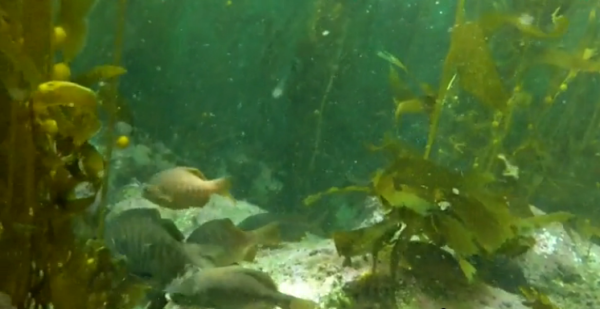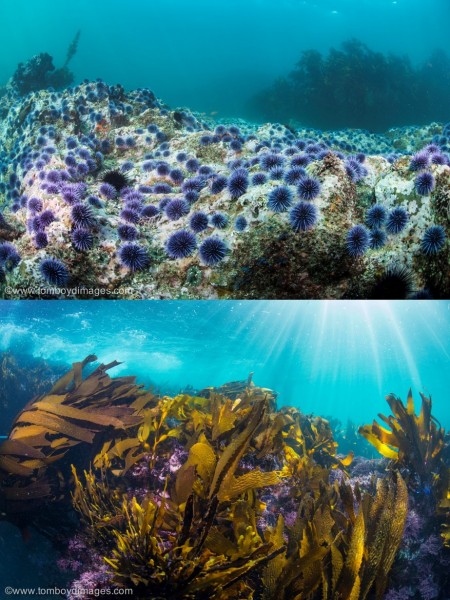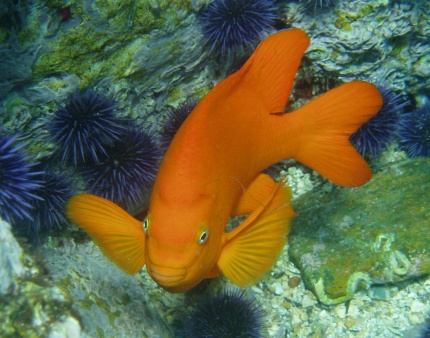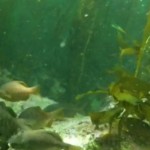Finally. A SoCal forest that’s been lying in ruins since the 1950s is getting proper attention and love.
Not a trees-on-land forest; this SoCal oceanic giant kelp forest off the Palos Verdes Peninsula coastline represents seaweed at its finest and is a testament to the power of nature to rebound after devastating decimation.
It’s estimated that this PV Peninsula forest has declined 75 percent in the past 100 years — but things are about to change thanks to a five year program headed up by The Bay Foundation (TBF).
Thanks to a hodgepodge partnership of trained volunteers, nonprofit organizations and fishermen associations along with federal and state agencies, the Palos Verdes kelp forest is once again thriving and beckoning local wildlife. At last count, more than 700 wildlife species including fish, crabs, sea birds, arthropods, sea lions and more, depend on the flowing undulating fronds of this ocean plant – and divers are now seeing many of these critters (such as the kelp bass, garibaldi, California sheephead, California spiny lobster and the two-spot octopus) returning.

“Rich, fat and happy,” is how Tom Ford, Executive Director of TBF describes the giant kelp plants that have taken root and sprung upward 30 feet to the surface. Ford explains that because the kelp has grown so quickly (the plant can grow about 2 feet a day), much of the new kelp has spread across the top of the water thick and strong enough to support hungry egrets walking searching for a slippery snack.

And guess what? It’s only been less than a year that this remarkable transformation has taken place, proving that nature doesn’t need complicated programs or intricate procedures to replenish what was lost. Often, the right jump start gives nature all it needs.
At one time, kelp so thick and tall was the norm in Southern California and provided many a marine critter home, food and more, but the post WWII building boom brought pollution, urban and storm water runoff, non-conservationist construction practices and sediment unceremoniously dumped into the ocean.
The kelp choked and wildlife left, except for scrappy sea urchins. With no kelp, the urchin’s natural predators – spiny lobsters, California sheephead and sea otters – disappeared leaving the urchins to multiply like crazy creating barrens which crowded out most other sea life.
Launched in July 2013, the restoration project brought 35 scientifically-trained SCUBA divers to cull down the urchins to a manageable number. Nearly 2 million purple sea urchins were removed from two coves: Underwater Arch and Honeymoon Cove. All in all, this 12 of acres have seen a dramatic kelp explosion with hundreds of plants stretching 25 feet or more. Urchin barrens, no more! This is pretty dramatic footage:
The resilience of the kelp helped the divers who didn’t need that extra step of planting plugs and starting the kelp from scratch. The kelp was just waiting for room which allowed it to spring up.
Project partners include: California Sea Urchin Harvesters, Vantuna Research Group, National Oceanic and Atmospheric Administration (NOAA), Department of Fish and Wildlife (DFW), Southern California Marine Institute, Los Angeles Waterkeeper, California Science Center, and TBF.
This is only the beginning. Only 12 of the 150 acres were part of this initial project and work will continue for the next four years to complete the transformation. Along the way, scientists and researchers will monitor the kelp growth and the return of wildlife.
Ford says that the Santa Barbara and Anacapa Islands are next in line for local kelp restoration but that researchers in British Columbia, Japan, Iceland and France are keenly watching the SoCal progress and will apply the same methods to their own kelp restoration projects.
“What we do here can affect ecologies around the world,” says Ford. “When you change a foot at a time on the ocean floor, you can recreate what was lost. And we are seeing that here in a wonderfully dramatic way.”

